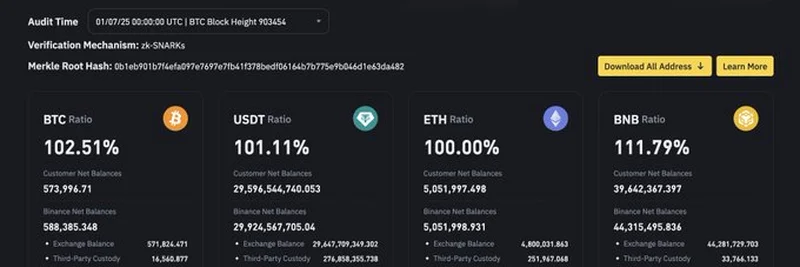Hey there, crypto enthusiasts! If you’ve been keeping an eye on the X platform lately, you might have stumbled across a heated discussion sparked by MartyParty (@martypartymusic) on August 1, 2025. This thread is raising some serious eyebrows about Binance, one of the biggest names in the crypto exchange world. Let’s break it down in a way that’s easy to digest, even if you’re new to the blockchain game.
What’s the Buzz About?
MartyParty dropped a bombshell by questioning why Binance is sending tens of thousands of Solana ($SOL) tokens and thousands of Ethereum ($ETH) tokens daily to Wintermute, a well-known market maker, while their proof of reserves report claims they hold no $SOL or $ETH outside of customer funds. The proof of reserves is supposed to be a transparency tool, showing that an exchange has enough assets to cover all user deposits—think of it like a bank statement for crypto. Binance’s report even boasts a 100% backing ratio, meaning they claim every user asset is fully secured. But if they’re shipping out these tokens, where are they coming from?
Check out the evidence Marty shared:
The first image shows Binance’s proof of reserves dashboard, highlighting ratios like 100.03% for $SOL and 100.00% for $ETH, with all balances tied to customer funds. The second image reveals a detailed log of transactions, showing consistent transfers to Wintermute. This discrepancy has sparked a firestorm of speculation.
Digging Into the Claims
So, what’s going on here? Proof of reserves is a big deal in crypto because it reassures users that their funds aren’t being misused. Exchanges like Binance use audits and tools like Merkle trees (a fancy way of verifying data integrity) to prove they’ve got a 1:1 match between user deposits and their holdings. But Marty’s pointing out a potential loophole: if Binance is sending assets to Wintermute, a third-party market maker, could those be customer funds being moved without clear disclosure?
Wintermute’s role is to provide liquidity—basically keeping the market flowing smoothly by trading large volumes. It’s not unusual for exchanges to work with market makers, but the question is whether these transfers are part of normal operations or something shadier, like rehypothecation (where funds are reused for other purposes, like lending or trading, without user consent). If Binance’s own reserves are zero for $SOL and $ETH, yet they’re sending out tokens, it raises red flags about where those assets originate.
The Community’s Reaction
The X thread blew up fast. Users like @freedomtwitty called it outright theft, while @C_dem_ suggested Binance’s former CEO, CZ, might be “playing dirty games.” Others, like @Easynineteen1, asked if Wintermute counts as third-party custody, which could change how we interpret these transfers. The consensus? People want answers, and they’re tagging SEC officials like @SECPaulSAtkins and @HesterPeirce for a response. This could be a pivotal moment for regulatory oversight in the crypto space.
What Does This Mean for You?
If you’re holding assets on Binance, this might make you a bit uneasy. The “not your keys, not your crypto” mantra reminds us that centralized exchanges hold your funds, and any mismanagement could lead to losses—like the infamous FTX collapse. While there’s no hard proof of wrongdoing yet, this situation underscores the importance of understanding where your crypto lives. Maybe it’s time to consider a hardware wallet or a decentralized exchange (DEX) for more control.
Looking Ahead
This controversy is still unfolding as of 05:44 AM JST on August 2, 2025. Binance hasn’t responded publicly yet, but the crypto community is watching closely. Will this lead to stricter audits or even regulatory action? For now, it’s a reminder to stay informed and skeptical. Keep an eye on meme-insider.com for the latest updates, especially if this spills over into the wild world of meme tokens, where transparency is just as crucial.
What do you think—is this a storm in a teacup or a sign of deeper issues? Drop your thoughts in the comments, and let’s keep the conversation going!



